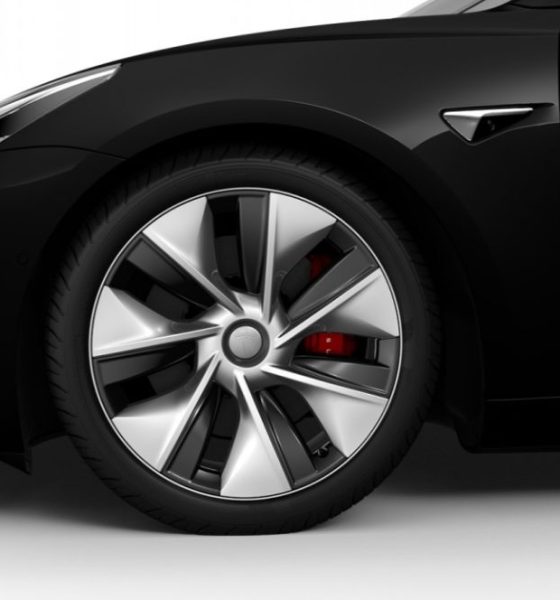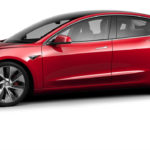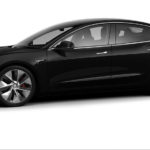

News
Tesla Model 3 Performance gets 19-inch “Power Sports” Aero Wheels in China
Just a few days into 2019, Tesla has opened the Model 3 configurator to customers in China and select European territories, allowing reservation holders to design and order the electric sedan. With this, Tesla has begun laying the foundations of the Model 3’s international ramp, which is expected to hit its stride in the coming months.
Within the configuration pages of the Model 3 in China, though, lay a rather surprising detail. When designing the Model 3 Performance in Tesla’s Chinese website, a new type of wheel for the vehicle was listed as an option. Instead of the 20″ Sport Wheels that are offered with the Model 3 Performance in the United States, China-bound vehicles are offered with 19″ “Power Sports” wheels.
The Model 3 Performance’s 19″ Power Sports wheels. (Credit: Tesla)
Tesla notes in the items’ description that the Power Sports wheels are designed for “balanced performance and cruising range.” Just like the 18″ Aero Wheel covers in North American vehicles, the 19″ Power Sports wheels include a detachable hubcap that can “better adapt to different road conditions.” Based on Tesla’s Model 3 configurator in China, the 19″ Power Sports wheels are exclusive to the Model 3 Performance; thus, customers who order the Long Range AWD Model 3 are only able to choose between the familiar 18″ Aero Wheels and the 19″ Sports Wheels found in North American units.
Tesla appears to have done a great job in designing the 19″ Power Sports wheels. Unlike the 18″ Aero Wheels, whose design is still polarizing, the 19″ Power Sports wheels could only be described as a very good balance between form and function. While it is unfortunate that the Power Sport wheels are currently unavailable for Model 3 in regions outside China, one can only hope that the wheels might eventually be released to other regions in the near future.
Considering that the new wheels have aero components, it would be quite interesting to see how Tesla’s new Power Sports wheels affect the Model 3 Performance’s range. That said, if their range optimization capabilities are anywhere close to the company’s 18″ Aero Wheels, then the 19″ Power Sports wheels could very well be the best wheel option for the Model 3 that the electric car maker has introduced to date.
The Tesla Model 3 Performance is poised to become a strong contender in China’s high-performance sedan market. Being capable of accelerating from 0-60 mph in 3.5 seconds, the vehicle is incredibly quick, and thanks to the Track Mode update, the car is capable of being driven on a closed circuit. Perhaps even more notable, though, is the vehicle’s price.
Last month, the Chinese State Council Customs Tariff Commission announced that it was suspending the extra 25% tariffs it placed on cars and parts being imported from the United States. This resulted in Tesla adjusting the Model 3 Performance’s price from a rather steep 689,000 RMB (roughly $100,000) to a more reasonable 560,000 RMB (around $81,000). At these prices, the Model 3 Performance actually undercuts some of its most notable fossil fuel powered rivals such as the BMW M3 and the Mercedes-AMG C 63 Coupe, which cost as much as 998,000 RMB ($162,000) and 1,198,000 RMB ($173,623), respectively.
With its current price, Tesla has practically made the Model 3 Performance one of the most bang-for-your-buck high-performance sedans in China.

Elon Musk
SpaceX issues statement on Starship V3 Booster 18 anomaly
The incident unfolded during gas-system pressure testing at the company’s Massey facility in Starbase, Texas.

SpaceX has issued an initial statement about Starship Booster 18’s anomaly early Friday. The incident unfolded during gas-system pressure testing at the company’s Massey facility in Starbase, Texas.
SpaceX’s initial comment
As per SpaceX in a post on its official account on social media platform X, Booster 18 was undergoing gas system pressure tests when the anomaly happened. Despite the nature of the incident, the company emphasized that no propellant was loaded, no engines were installed, and personnel were kept at a safe distance from the booster, resulting in zero injuries.
“Booster 18 suffered an anomaly during gas system pressure testing that we were conducting in advance of structural proof testing. No propellant was on the vehicle, and engines were not yet installed. The teams need time to investigate before we are confident of the cause. No one was injured as we maintain a safe distance for personnel during this type of testing. The site remains clear and we are working plans to safely reenter the site,” SpaceX wrote in its post on X.
Incident and aftermath
Livestream footage from LabPadre showed Booster 18’s lower half crumpling around the liquid oxygen tank area at approximately 4:04 a.m. CT. Subsequent images posted by on-site observers revealed extensive deformation across the booster’s lower structure. Needless to say, spaceflight observers have noted that Booster 18 would likely be a complete loss due to its anomaly.
Booster 18 had rolled out only a day earlier and was one of the first vehicles in the Starship V3 program. The V3 series incorporates structural reinforcements and reliability upgrades intended to prepare Starship for rapid-reuse testing and eventual tower-catch operations. Elon Musk has been optimistic about Starship V3, previously noting on X that the spacecraft might be able to complete initial missions to Mars.
Investor's Corner
Tesla analyst maintains $500 PT, says FSD drives better than humans now
The team also met with Tesla leaders for more than an hour to discuss autonomy, chip development, and upcoming deployment plans.

Tesla (NASDAQ:TSLA) received fresh support from Piper Sandler this week after analysts toured the Fremont Factory and tested the company’s latest Full Self-Driving software. The firm reaffirmed its $500 price target, stating that FSD V14 delivered a notably smooth robotaxi demonstration and may already perform at levels comparable to, if not better than, average human drivers.
The team also met with Tesla leaders for more than an hour to discuss autonomy, chip development, and upcoming deployment plans.
Analysts highlight autonomy progress
During more than 75 minutes of focused discussions, analysts reportedly focused on FSD v14’s updates. Piper Sandler’s team pointed to meaningful strides in perception, object handling, and overall ride smoothness during the robotaxi demo.
The visit also included discussions on updates to Tesla’s in-house chip initiatives, its Optimus program, and the growth of the company’s battery storage business. Analysts noted that Tesla continues refining cost structures and capital expenditure expectations, which are key elements in future margin recovery, as noted in a Yahoo Finance report.
Analyst Alexander Potter noted that “we think FSD is a truly impressive product that is (probably) already better at driving than the average American.” This conclusion was strengthened by what he described as a “flawless robotaxi ride to the hotel.”
Street targets diverge on TSLA
While Piper Sandler stands by its $500 target, it is not the highest estimate on the Street. Wedbush, for one, has a $600 per share price target for TSLA stock.
Other institutions have also weighed in on TSLA stock as of late. HSBC reiterated a Reduce rating with a $131 target, citing a gap between earnings fundamentals and the company’s market value. By contrast, TD Cowen maintained a Buy rating and a $509 target, pointing to strong autonomous driving demonstrations in Austin and the pace of software-driven improvements.
Stifel analysts also lifted their price target for Tesla to $508 per share over the company’s ongoing robotaxi and FSD programs.
Elon Musk
SpaceX Starship Version 3 booster crumples in early testing
Photos of the incident’s aftermath suggest that Booster 18 will likely be retired.

SpaceX’s new Starship first-stage booster, Booster 18, suffered major damage early Friday during its first round of testing in Starbase, Texas, just one day after rolling out of the factory.
Based on videos of the incident, the lower section of the rocket booster appeared to crumple during a pressurization test. Photos of the incident’s aftermath suggest that Booster 18 will likely be retired.
Booster test failure
SpaceX began structural and propellant-system verification tests on Booster 18 Thursday night at the Massey’s Test Site, only a few miles from Starbase’s production facilities, as noted in an Ars Technica report. At 4:04 a.m. CT on Friday, a livestream from LabPadre Space captured the booster’s lower half experiencing a sudden destructive event around its liquid oxygen tank section. Post-incident images, shared on X by @StarshipGazer, showed notable deformation in the booster’s lower structure.
Neither SpaceX nor Elon Musk had commented as of Friday morning, but the vehicle’s condition suggests it is likely a complete loss. This is quite unfortunate, as Booster 18 is already part of the Starship V3 program, which includes design fixes and upgrades intended to improve reliability. While SpaceX maintains a rather rapid Starship production line in Starbase, Booster 18 was generally expected to validate the improvements implemented in the V3 program.
Tight deadlines
SpaceX needs Starship boosters and upper stages to begin demonstrating rapid reuse, tower catches, and early operational Starlink missions over the next two years. More critically, NASA’s Artemis program depends on an on-orbit refueling test in the second half of 2026, a requirement for the vehicle’s expected crewed lunar landing around 2028.
While SpaceX is known for diagnosing failures quickly and returning to testing at unmatched speed, losing the newest-generation booster at the very start of its campaign highlights the immense challenge involved in scaling Starship into a reliable, high-cadence launch system. SpaceX, however, is known for getting things done quickly, so it would not be a surprise if the company manages to figure out what happened to Booster 18 in the near future.











